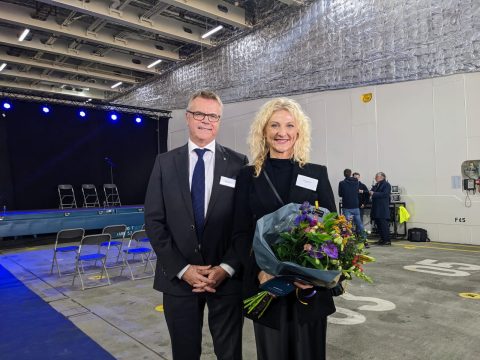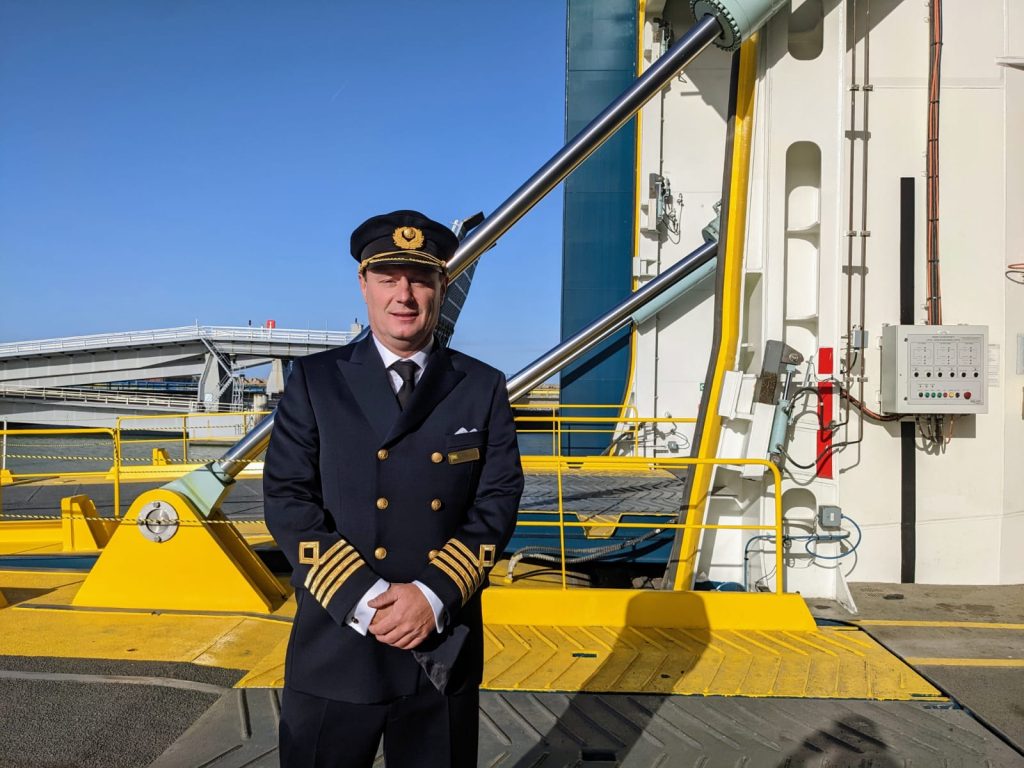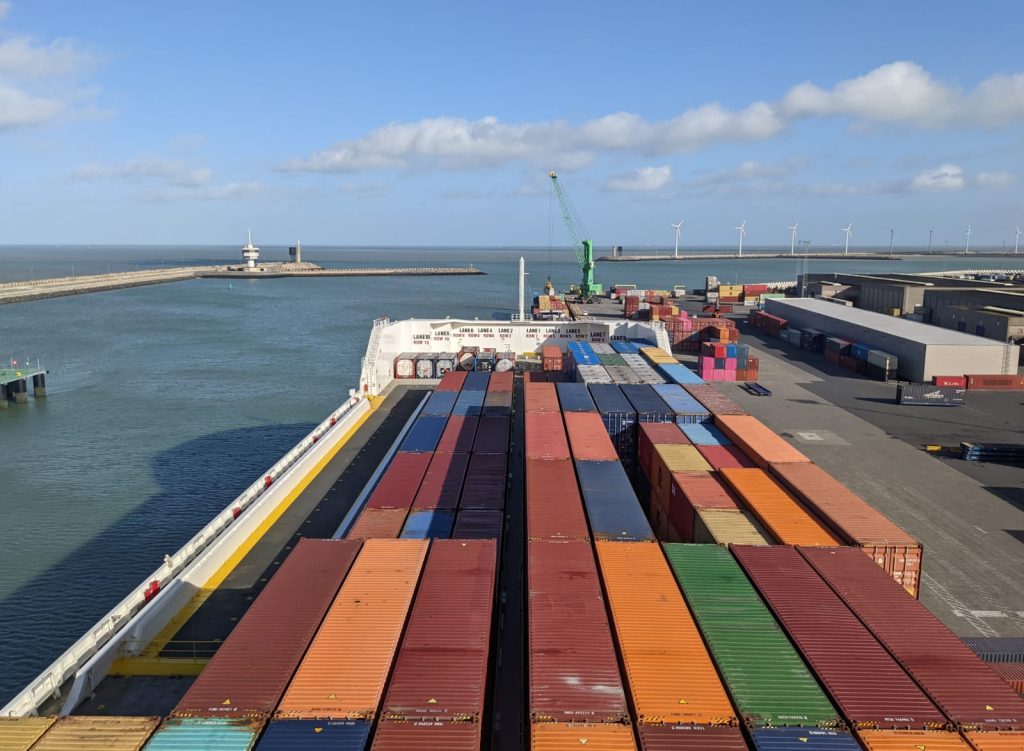
Wallenius Sol’s Baltic Enabler christened in Bruges
The world’s largest ice-rated ConRo vessel, the Baltic Enabler, was christened in the PSA Zeebrugge multipurpose terminal in Bruges, Belgium, on Wednesday, 2 November 2022.
The ceremony began with a reception at the ABC Tower in Zeebrugge Lounge. From there, guests were brought by bus to the PSA Zeebrugge Terminal, for the naming ceremony. Guests entered the vessel’s hold through the Baltic Enabler’s main ramp, to the sound of the local De Speelschaar marching band. The vessel is equipped with three independent stern ramps, to easily adapt to different terminal conditions. The main ramp has a safe working load (SWL) of 300 tonnes, while the two side ramps have a SWL of 150 tonnes.
The ship’s captain, Tobias Åkerblom, and Pontus Vahlsten, chief engineer at Wallenius Lines, were also there to personally welcome visitors. Following a rendition of the Swedish and Belgian national anthems, refreshments were served, and Ragnar Johansson, managing director of Wallenius Sol, took the floor. After welcoming everyone, he explained: “Having our facilities in the far north has its share of challenges, due to frozen ice for months throughout the year. Competitiveness requires frequent, reliable and sustainable transports to the Baltic Sea region.” These considerations guided the vessel’s design, a collaboration between Wallenius Marine and Knud E Hansen.

“This is the largest ice-class ro-ro vessel, she is built to the highest environmental standards, with the highest ice class: 1A Super. The vessel is itself an ice breaker, able to cut through one metre of solid ice, and at the same time carry 28,000 tonnes of cargo,” continues Mr Johansson. More specifically, the vessel has a cargo capacity of 6,442 lane metres and 960 TEU. Overall, the vessel has a gross tonnage of 59,821 metric tonnes, measuring 242 metres in length, and 35.2 metres in width. Wallenius Marine is responsible for the manning and technical operation of the vessel.
Sustainability minded
In addition to its considerable size, the vessel is remarkable in its high environmental performance. Senior Vice-President of Wallenius Lines, and board member at Wallenius Sol, Anders Thyberg, stated: “By putting the environment at the top of its corporate agenda, Wallenius Sol has taken industry leadership in response to climate change. (…) We are exceptionally proud to be the Enabler to the Nordic green revolution.”
The Baltic Enabler “is 57% more energy efficient than the ships she is replacing which means that the greenhouse gas emissions are reduced as much when she is running on fossil fuels,” said Mr Johansson. Compared to existing ships running on marine gasoil (MGO), per shipped tonne of cargo, there is a 99% reduction in Sulphur dioxide, a 96% reduction in Nitrogen oxides (NOx), and a 99% reduction in fine particulate matter (PM2.5). This is according to the Swedish Environmental Research Institute (IVL).
Multi-fuel operations
“Our objective is, however, to have her be 100% fossil free, through our ability to use biogas or other fossil-free fuels,” continues Mr Johansson. Indeed, both of the ship’s 900 KW engines can run on liquefied natural gas (LNG), liquefied biogas (LBG), diesel and synthetic diesel. Shore power connection is also prepared. As a result, the vessel will be able to adapt to whichever fuel mix ends up powering the shipping industry’s future. In monetary terms, a reduction of costs ranging from 2.3 and 11.8 million euros can be expected.
The LNG is stored onboard the vessel in large tanks, in which it is kept at -163 degrees celsius. It is from the engine room that the switch can be made from diesel power to LNG power, once at sea. “Switching back to diesel when approaching port takes only minutes,” adds Vahlsten. He also explains that the full capacity of the vessel is only used when it needs to break through thick ice. In more clement conditions, less fuel needs to be used, even when maintaining the ship’s maximum speed of 20 knots.
Inside the Baltic Enabler
The vessel’s godmother, and wife of managing director Ragnar Johansson, Anette Johansson, christened the vessel by breaking a bottle of champagne against the hull. Guests were then taken on a tour of the vessel. From the main cargo hold, they were brought to the cargo control room. Equipped with CCTV, and anti-heeling technology, it is from this room that ballast is monitored and controlled, to ensure smooth load out of cargo.
After visiting the engine room, and gas storage system, guests were taken one level higher to the cargo deck, which has a capacity of approximately 128 trailers, and four tonnes per square metre. The deck above this space has a capacity of about 800 TEU. This level is also that of the mooring station, with ropes on winches that have a SWL of 92 tonnes. The vessel also disposes of two cranes, one on the port side and one on the starboard side, used for loading provisions, with a SWL of 5 tonnes.

Crew accommodations
Currently, 17 crew members work on the vessel, in four-hour shifts. In terms of accommodations, one crew member says, “we are pampered here.” The vessel is equipped with a gym including a ping-pong table, and, in keeping with nordic tradition, a sauna. A movie room which seats nine is accessible from the Atrium lounge. There is also a TV and karaoke machine in the day room on the crew deck. The crew eats in an elegantly decorated dining room, complete with sea views. Two cooks work in the galley.
One floor up is the ‘driver’s mess’ and cabins. Indeed, in addition to the crew cabins, the vessel can host up to 12 guests, generally truck drivers accompanying their rig to their destination. There are also allocated cabins for the captain, and for the owner, as well as a conference room and offices. Lastly, the vessel has a small onboard hospital, where the second officer can treat minor injuries. In case of emergency, the crew also has first aid training.
Godmother Anette Johansson commented: “It makes me very happy when I see how much has been invested in the well-being of the crew. The crew spends several months on boards and I know how important it is to feel comfortable and proud of your ship. On board the Baltic Enabler, I’m confident the crew will thrive. A special thanks to Margareta Wallenius-Kleberg, who spent three days aboard the vessel, and made it pleasant with paintings, plants, and ornaments. The warmth of your action is unique.”
Spirit of collaboration
After visiting the Baltic Enabler, guests returned to the ABC Tower for a luncheon. “Because we had the first naming ceremony in a Swedish port, Skelleftea, it was natural to have this event here, as we have many customers here; want to show them what they are involved in.” said Ragnar Johansson. Customers and collaborators including Northvolt, Metsä, Stora Enso, Navonus, and representatives from the Port of Antwerp-Bruges were therefore present.
“Being able to present a vessel of this kind, in this weather, in such a hub, is wonderful. (…)This shows what we can do if we get it right. There are many people involved in getting there. I want to thank our skilful crew, captain, partners, banks, agencies… That’s what life is about: trying to do good things, and trying to do them together,” added Jonas Kleberg, owner and chairman of Wallenius Lines.
Fair winds
“Building this in China during the COVID-19 pandemic turmoil was both exciting and challenging. It was not possible to travel from Europe to China to visit the shipyard…” explained Thyberg. Indeed, both the Baltic Enabler and its sister vessel, the Botania Enabler, were built by Yantai CIMC Raffles Shipyard, a shipbuilding company in Yantai, Shandong Province, in China. The ships also both sail under the Swedish flag.
The ship’s maiden voyage from the shipyard in China where it was built, to Europe, ended on August 18th, when the Baltic Enabler passed the Wandelaar pilot station on its way into the port of Zeebrugge in Belgium, its first European call. Since 25 August 2022, both Enabler ships have been in service on the Zeebrugge – Antwerp – Kokkola – Skelleftea – Oulu – Kemi – Travemünde route. The Baltic Enabler left the PSA Zeebrugge terminal at 4 PM on Wednesday.
Baltic Enabler Visit from ProMedia Group on Vimeo.




